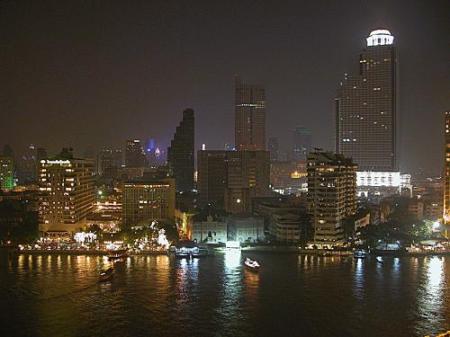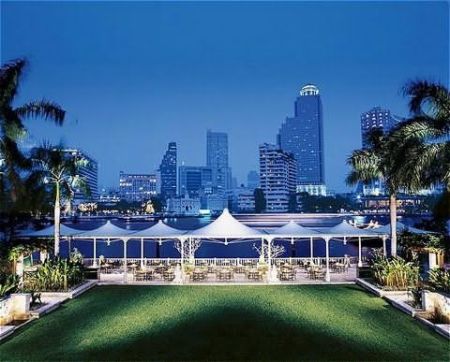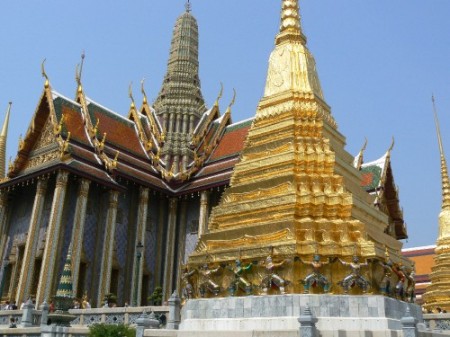Thailand’s capital is divided by the Chao Phraya River and is
nestled in one of the world’s most fertile rice-producing
deltas.Bangkok’s 579 square miles (1,500 sq km) are criss-crossed by a
series of canals carrying passengers and cargo, its roads clotted with
endless traffic jams, while the city sprawls in all directions with a
hodge-podge of urban, commercial and industrial buildings. A new
overland metropolitan railway speeds above the city, providing visitors
with a relaxed and efficient way to observe the hustle and bustle below.
Despite its pollution and overcrowding, Bangkok is undoubtedly one
of Asia’s most exciting cities, and one of the world’s largest,
promising to reveal to each traveller the wild and untamed mysteries of
the east. On the banks of the Chao Phraya visitors will find the Grand
Palace as well as Wat Phra Kaeo, the palace temple housing the Emerald
Buddha, constructed entirely from translucent green jade. Slightly
upriver are the exquisitely ornamented Royal Barges, still used today
for special floating processions.
Of the 30 or so temples in Bangkok, the largest is the Temple of
the Reclining Buddha, which houses an impressive statue of the deity.The
famous Floating Market is a delight to visitors and well worth a visit.
As the sun lurches towards the horizon in the west and the sweat cools,
this city of royalty and religion comes alive with a palpable
decadence. Music and dazzling neon advertise a miasma of trendy bars and
nightclubs, as well as the notorious ‘girlie joints’ that have ensured
the Patpong district its reputation for hedonism.
Here, bubbling in the crucible of a city 23 times larger than its
next in line, Chiang Mai, west meets east, frantic meets tranquil and
traditional meets modernity in an assault on the senses that gives
Bangkok an unbeatable buzz.
It’s certainly not easy to get around – this is the city that defines the phrase traffic chaos, and boasts some of the highest pollution levels of any in the world.
It’s certainly not easy to get around – this is the city that defines the phrase traffic chaos, and boasts some of the highest pollution levels of any in the world.
The royal island was surrounded by a watery network of canals, or
khlongs, nicknamed the Venice of the East by travellers, but as Bangkok
grew most of the canals were filled in in favour of roads, houses and
eventually glass skyscrapers.The watery legacy lives on these days in
the traditional khlongs of Thonburi, a district on the west bank of the
river, and in the river itself, snaking majestically through the city as
longtail boats and ferries scuttle back and forth across it like
frenetic insects.
On the east bank, Bangkok proper is a world away from the fluid peace of Thonburi.
At first glance the city seems resolutely modern; buses, tuk-tuks and taxis honk and speed, sun glitters off the concrete and glass skyscrapers in Silom, Siam Square and Sukhumvit and shopping malls and stalls hum with trade.
It’s this commercial enthusiasm that has made Bangkok a shopping paradise, for everything from silk to fake designer handbags.
In the sois of Patpong, the infamous red light district is the distasteful side of Bangkok’s commercial enterprise – and something that continues to blight the city with a reputation as one of the sex capitals of the world.
Most of the city’s interest lies well within the city limits, and the sights of Greater Bangkok are few and far between, although the famous Chatuchak weekend market on the outskirts is not to be missed.
At first glance the city seems resolutely modern; buses, tuk-tuks and taxis honk and speed, sun glitters off the concrete and glass skyscrapers in Silom, Siam Square and Sukhumvit and shopping malls and stalls hum with trade.
It’s this commercial enthusiasm that has made Bangkok a shopping paradise, for everything from silk to fake designer handbags.
In the sois of Patpong, the infamous red light district is the distasteful side of Bangkok’s commercial enterprise – and something that continues to blight the city with a reputation as one of the sex capitals of the world.
Most of the city’s interest lies well within the city limits, and the sights of Greater Bangkok are few and far between, although the famous Chatuchak weekend market on the outskirts is not to be missed.
Accommodation is plentiful in Bangkok, with good options in all price
ranges – hotels along the river are generally the most luxurious, with
the best views and the easiest transport options from river boat piers
along the banks.Sukhumvit Road and Siam Square in the east of the city
offer a good range of keenly priced, well-located guesthouses and
smaller hotels, while for the lowest priced options, Khaosan Road, also
known as Banglamphu, has long been the backpackers ghetto.
Bangkok is the main entry point for visitors to Thailand, many of
whom go on to explore other parts of the country, including the beaches
of Southern Thailand and islands of Phuket and Koh Samui.
Closer to the city, trips can be made to the ruins of Ayutthaya, the former capital, 90 minutes by train to the north of Bangkok, the floating markets of Damnoen Saduak to the southwest and the town of Kanchanaburi to the northwest, site of the real-life Bridge over the River Kwai.
Closer to the city, trips can be made to the ruins of Ayutthaya, the former capital, 90 minutes by train to the north of Bangkok, the floating markets of Damnoen Saduak to the southwest and the town of Kanchanaburi to the northwest, site of the real-life Bridge over the River Kwai.







0 comments:
Đăng nhận xét